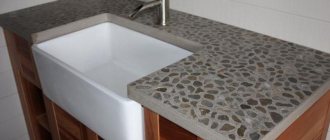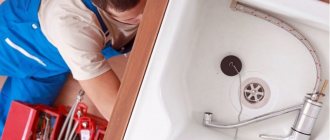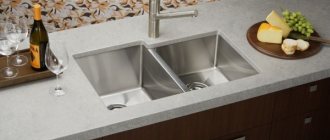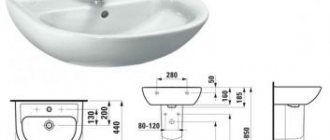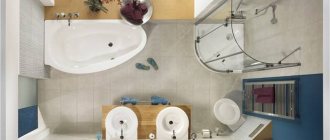—banner in article 2—-
In standard apartments, bathrooms are usually of modest size. Apart from a few plumbing fixtures - a bathtub and a sink - practically nothing can be placed in them. Installing a sink above the washing machine will help solve the problem in a small area. We will tell you in detail how to do this with your own hands in this article.
Requirements for installing a sink
The bathroom is a room with high humidity, and under the sink, where the drain pipe and siphon are located, there is also a high risk of leaks. All electrical equipment must be grounded and protected from water.
When installing a washbasin above a washing machine, you must fulfill the following requirements:
- the height of the sink bowl is no more than 20 cm;
- width and depth - 2-5 cm larger than the dimensions of the machine;
- washbasin drain - is not located above the device, but only on the side or back.
Drawing of a sink for installation above the washing machine
If these conditions are met, the electrical equipment is not in danger of being flooded with water even if the siphon leaks. It is recommended to use specially designed washbasin models for combination with washing units.
What materials are they made from?
Sinks for installation above a washing machine, like any plumbing fixtures, are made of porcelain and earthenware. Earthenware is cheaper, but has a more porous structure and is itself hygroscopic. To overcome these shortcomings, the surface is covered with glaze. When applied properly, the product has a good appearance and does not get wet. But after a while the glaze may crack. The cracks are microscopic, but dirt gets stuck in them, the surface becomes grayish, and nothing can be done about it. Therefore, earthenware has to be changed often.
Article on the topic: Do-it-yourself flower beds in the country. Photo ideas for flower beds
Porcelain car wash
Porcelain sinks cost more and weigh more, but they are more durable. The surface is smoother, dirt does not settle on it, and it is easier to keep clean.
Sinks made of artificial stone are often found. This is a mixture of polymer with stone dust and chips. The high plasticity of the mass allows you to obtain any shape, achieve any colors and shades.
Sinks are made from artificial stone according to customer sizes
There are companies that are ready to make sinks strictly according to your dimensions. Naturally, individual production is more expensive, but the available space is used rationally.
Another custom option
Advantages and disadvantages of sinks over a washing machine
The main advantage of this arrangement is space saving. For small apartments, it is sometimes very difficult to choose another option. The kitchen or hallway are not the most convenient places to connect a washing machine.
The design of the washing machines is neutral and fully matches the modern style of the bathroom. In addition, you can connect to the water supply from the riser in one place, just like cutting into the sewer, which reduces the amount of work and materials. Usually the siphon that comes with the kit has an additional pipe for connecting the drain from the washing machine.
And finally, the third advantage is the ease of washing, which all housewives will appreciate. Sometimes pre-washing of clothes or other manipulations are required, which requires at least a small sink. And in this case, everything is nearby - both the machine and the bowl of cold and hot water.
There is only one drawback to the close proximity of a washbasin and washing machine - the danger of water getting on the electrical parts of the machine. Therefore, when installing equipment, you need to do everything possible to eliminate such a situation.
Pros and cons of a sink above a washing machine
There are many advantages to placing a washing machine under the sink . If the bathroom has minimal dimensions, then we could get rid of the bath itself, replacing it with a shower stall and gaining space for a washing machine. But since we chose a special sink and a special small-sized washing machine, the bathtub will remain in place, which is a big plus.
By placing the washing machine under the sink, we significantly save space in small bathrooms without cluttering them with unnecessary elements. For example, by completing this arrangement, we can find a place for installing a laundry tank. If we installed a regular full-size washing machine, the laundry would remain stored in the bathtub or outside the bathroom.
There are also plenty of disadvantages:
- The need to purchase a special washing machine;
- High sink position when using a standard washing machine;
- The complexity of connecting the machine due to the lack of free space;
- The need to purchase and install a special water lily sink;
- Small capacity of small-sized washing machines.
- A sink-lily for placement above an automatic washing machine is itself a great rarity; you still have to look for it. Similarly, you will have to suffer with the choice of a washing machine - small-sized models are also very rare. Otherwise, we will have to put up with a high position of the top edge of the sink.
- Installing a machine and a sink in narrow bathrooms is a unique “pleasure”, so here we will have to work hard, trying to turn around with tools in a minimum of space.
Choosing a washing machine
For installing household appliances together with a washbasin, only fairly compact washing machines are suitable, whose dimensions must correspond to the dimensions of the bowl:
- maximum height - 70 cm;
- width - 60 cm;
- depth 45-50 cm.
The capacity of such devices does not exceed 3.5 kg of laundry. Sometimes “babies” are immediately equipped with a “water lily” sink with a special siphon. The price of the set is more expensive than the standard one, but there will be no problems with installation.
Not every family can limit itself to a small amount of washing, so they buy a machine with a load of up to 4-5 kg, and then select a sink. But with the standard height of the machine, another 20-25 cm will be required for the washbasin, that is, the total height will be at least 105-110 cm. For ergonomic reasons, it is optimal if the sink does not rise more than 85 cm, so it will be inconvenient to use.
An example of choosing a washing machine by height
The depth of the machine should not be more than 45-50 cm, since utilities and a siphon will be located at the rear. You need to step back at least 8 cm from the back wall. A prerequisite for a washing machine under the sink is front loading and control using the functionality on the front panel. Models with a loading hatch on top will not work.
What washing machines can be installed under the sink?
Small washing machines can be installed under the lily sink. They should be low and shallow. For people of average height, washbasins in the bathroom are installed at a height of 80 cm. Taking into account that the sink has a depth of about 20 cm, the height of the washing machine should be about 60 cm. For tall people, the normal installation height of the sink is up to 100 cm. In this case, the washing machine the machine can be about 80 cm high.
Related article: Which plinth is suitable for a stretch ceiling and how to glue it
An example of choosing a washing machine under the sink by height
When installing, do not forget to leave a gap between the body and the siphon. When spinning, the machine can vibrate so that vibration is not transmitted and this clearance is required.
The depth of the machine is also selected based on the size of the sink (or vice versa, depending on what is already available). On average, with a sink size above the sink of 50 cm, the depth of the washing machine is 32-36 cm, with a sink of 60 cm - up to 51 cm.
When installing, please note that the siphon should not touch the body. The reason is the same - vibration during spinning.
Choosing a washing machine for washing by depth
There remains a substantial gap between the machine body and the wall, into which the sewer pipe can be successfully installed. If its diameter is larger, it can be partially hidden in the wall.
Rectangular
These washbasins follow the contours of the car. Small overhangs, like the edges of an umbrella, perfectly protect its surface from splashes.
The bowls are made of durable waterproof materials. Their height does not exceed 20 cm. The siphon is usually moved back so as not to interfere with the installation of the washing machine. The drain hole is located closer to the back or side surface of the “water lily”. The mixer can have 2 installation options - in the center or along the edges.
Semicircular
Differ from rectangular ones with a rounded bowl. There are no sharp corners, which makes them safer, and the bathroom environment softer and more comfortable.
Non-standard
Originally shaped sinks are an accent in the bathroom interior. The whimsical shape of the bowl attracts the eye and gives this utilitarian device an unusual look. Plumbing fixture designers compete to see who can come up with the brightest and most interesting idea. Of course, the price of such sinks cannot be low.
Optimal sizes
The width of the purchased plumbing fixtures must correspond to the dimensions of the washing machine.
If the household already has a washing machine, then the choice is quite limited and you will have to work with what you have. If you are just about to purchase this household appliance, then you should opt for compact models. The optimal dimensions of a machine for washing clothes are as follows: height no more than 60 centimeters, depth within 35 -45. Width does not play a special role here, so be guided by your taste.
In both cases, the following nuance must be taken into account. The height of the finished structure (sink + washing machine) should not exceed 75-80 centimeters. This is considered the best option. Using a “water lily” that is installed above or below the recommended level will be very problematic. At the same time, there should be a small gap between the plumbing and household appliances. You can calculate at what height the bowl will be using the following formula: height of household appliances + depth of the bowl + 10-15 centimeters of reserve.
USEFUL INFORMATION: Installing a siphon on a bath (video): how to properly assemble a bath siphon
There is also a third option: purchase a ready-made bathroom set. It includes a washing machine and a sink made specifically for it. The only drawback of such designs is that these products are mainly produced abroad, and therefore their price is appropriate. Not every family can afford to spend almost the entire monthly budget on purchasing this pleasure.
Design features of “water lilies”
Unlike conventional washbasins, the sink above the washing machine should be flatter so as not to add additional height. Another important condition is that the siphon should be located as close to the wall as possible. The gap between the surface of the machine and the bottom of the sink should be minimal. All these conditions are met by “water lily” models from different manufacturers.
For the production of shells they use:
- Earthenware is an inexpensive white material with a finely porous structure. To increase water resistance, it is coated with transparent or colored glaze.
- Porcelain is a denser and more durable type of ceramic. It has a slightly transparent surface and rings when struck lightly. Plumbing fixtures are decorated with glaze or gloss.
- Cast marble - the base is polymer concrete, to which marble chips are added. This is an artificial stone, invented not so long ago, but has already proven itself well.
Sinks made of earthenware or porcelain are easy to clean, last up to 25 years, but are susceptible to impacts. Care must be taken during installation. Cast marble is stronger and more resistant to abrasion than ceramics. In addition, the damaged surface can be quickly restored by simply polishing it with a special tool.
Choosing a sink and washing machine
The process of combining a sink with a washing machine usually begins with a trip to the plumbing store. There you need to purchase a suitable sink. The so-called water lilies are most suitable for your purposes. These are shallow, flat plumbing products made in the form of a countertop.
It is recommended to pay attention to the sink drainage diagram. The drain is usually horizontal or vertical. From a practicality point of view, a vertical drain is much more convenient - in a straight pipe, blockages are less likely to form. But if you install a sink above a washing machine, then it is better to give preference to models with a horizontal drain system. The fact is that the drain must be moved beyond the washing machine. This is required by basic fire safety rules. In this regard, products with horizontal drainage are much more convenient.
A brief overview of the most popular washbasins for installation on a washing machine
Plumbing manufacturers offer many options to meet demand. Among the “water lilies” you can find both very small models for narrow washing machines, and quite comfortable luxury ones that can be installed above machines up to 51 cm deep.
How to place water lily shells
“Water Lily” Compact 53.5 cm
The sink is almost square in size, measuring 53.5 x 56 cm with rounded corners. The height of the bowl is only 14 cm. It is made of porcelain with a white coating.
The compact, elegant “water lily” can be installed on a washing machine with a depth of up to 46 cm and a width of up to 54 cm. There is a hole in the left corner for the mixer, and a drain hole in the right side of the sink. Supplied with mounting bracket and siphon.
"Water Lily" Bolero 64 cm
The spectacular bowl of non-standard shape is quite large - 64x60 cm. It can be installed above any washing machine, provided that the depth of the machine does not exceed 46 cm. It is made from high-quality ceramics, equipped with a siphon and fasteners.
A distinctive feature of the Bolero water lily is its straight vertical drainage. The water drains quickly and there is virtually no risk of blockages. By closing the drain with a plug, you can do a mini-wash in the large bowl, or bathe a small child or pet.
"Water Lily" Quadro
Cast marble is used to make this washbasin. A square bowl measuring 60x60 cm is installed on washing machines with a depth of up to 46 cm of any height.
The strict geometry and modern design are emphasized by an original detail - a cover for a hidden drain hole made of stainless steel. The hole for the mixer is located in the middle.
"Water Lily" Long
An elongated model with a comfortable tabletop and towel holder. The dimensions of the sink are 50x80 cm, which dictates the need for free side space. The bowl is round, with a central drain hole.
A washing machine with a depth of up to 46 mm can be installed under this washbasin. Unlike other models, it is placed under the countertop, and directly under the sink you can place a laundry basket, a small cabinet or a cabinet.
Waterlily Lux-Light
Manufacturers created this model for lovers of rounded “soft” lines in the interior. Thanks to the thoughtful design, it seems that the sink is much smaller than its size, although its dimensions are 600x570 mm with a height of only 180 mm.
The Lux-Light water lily is made of cast marble with holes for a mixer and overflow. To improve drainage, there are 3 holes of increased diameter, so there is no risk of water stagnation or blockages in the washbasin. The model is designed for installation above a washing machine with a depth of up to 51 cm.
Advantages and disadvantages of installation
Such combinations were created in order to save free space. This way, you can place the necessary equipment in the bathroom, and not in the kitchen or, for example, in the hallway.
The range of sinks installed above the automatic machine is very large. Therefore, everyone will be able to choose a model that is suitable in design, material and cost. Such non-standard equipment will decorate your bathroom and allow you to make the most of its space.
However, some disadvantages of this solution can be identified. The components for sinks and automatic machines have a correspondingly higher cost compared to conventional plumbing equipment.
A compact automatic machine has less capacity. As a rule, the weight of laundry loaded into such a unit should not exceed 3.5 kg. Therefore, large families who often do a lot of laundry should think seriously before making such a purchase.
A standard washbasin will not fit above a washing machine. It is necessary to purchase a flat sink, which is equipped with additional fastening and a non-standard rear or side siphon for draining water. This fact often brings a lot of inconvenience. Due to this design of the washbasin, the outlet does not provide complete drainage, so the liquid must be removed manually. This type of sink also needs to be cleaned frequently to prevent the drains from clogging.
It has been noticed that installation of small-sized washing machines and sinks above them brings much more trouble than large household appliances. Therefore, in order to simplify the work of the master as much as possible, first take the exact dimensions of the bathroom and plumbing equipment.
Drains in sinks: features and types
To prevent water from the washbasin from getting onto the body of the machine, even in the event of a leak, the drain is located in the back or side of the bowl. Depending on the location, we can distinguish:
- Vertical drain. The siphon is located below the drain hole, so the water drains quickly, with minimal risk of blockage and leakage.
- Horizontal drain. The drain is located at a slight angle to the wall, which can cause clogging of the pipe lumen. But the siphon is located outside the washing machine, so water will not get into its body during leaks.
Many models have an overflow to drain water in case of obstruction of the main hole, removable soap dishes, plugs and other accessories.
Rules for installing washing machines under the washbasin
For safe operation of electrical equipment, you must follow the installation rules:
- the top of the washing machine must be completely covered by the sink from splashes;
- if a sewer pipe runs along the wall, the minimum width of the bowl is 580 mm, if there are no communications, then 500 mm;
- the drain pipes should not touch the machine, as they can be damaged by vibration;
- The machine must be installed strictly horizontally; if there is a slope, use rubber mats;
- Installation and connection must be carried out by a qualified specialist.
The washing machine must not be allowed to protrude from the front of the washbasin. It's inconvenient and unsafe.
If the washing machine protrudes from under the sink, then this is:
- inconvenient, as access to the sink is difficult: a person rests his knees on the machine.
- electrically hazardous.
According to the conclusion of a specialized organization authorized for testing household appliances - "Rostest", the sink installed with the washing machine must completely cover the machine from splashes.
Otherwise, the leakage currents exceed the permissible ones by 6-10 times, a short circuit in the machine control unit is possible and it fails, as well as electric shocks to the user.
Attention!
- Care must be taken at all times to ensure that the hoses are used correctly, as... any design change negatively affects the operation of the device.
- Install the washing machine in a warm room.
The owner of the machine is responsible for all damage resulting from improper use or care.
How to install a sink above a washing machine: installation instructions
Manufacturers usually complete their products with brackets, but before starting work you need to make sure that the fasteners are available. Some models provide for mounting on standard Soviet hooks, since the weight of the plumbing fixture itself is small. This allows you not to use old brackets and not to unnecessarily weaken the walls.
Preparation
First you need to dismantle the old washbasin, turn off the water supply, and check the horizontalness of the base for the washing machine. Prepare the hot and cold water outlets - wind the sealing tape, screw on the fittings. Install a tee with a tap to connect the machine to the cold water supply.
Connect a tee with an angle of 45° to the sewer pipe. One socket will be used for drainage from the sink, the other from the washing machine.
Fittings for connecting hoses are mounted on the outlets from the main pipeline.
Marking for fastenings
You need to mark the points on the wall where the brackets will be mounted. First, install the washing machine, put a sink on top and draw a horizontal line. To avoid drawing on the tiles and damaging its surface, it is recommended to use masking tape. Once the points for the brackets are marked, it can be removed.
Then the unit is removed, a washbasin is placed on the marked line and markings are made from below for the brackets.
Installation of brackets
Holes are drilled according to the markings and plastic dowels are driven in.
Sink assembly
Insert the water supply hoses into the holes provided for this purpose and secure with nuts. Screw the brackets to the sink.
Securing the washbasin
Place the assembled sink against the wall so that the holes on the brackets and the mounting points match. Screw in the anchors.
Connection to water supply and sewerage
Install the mixer, connect flexible hoses to the corresponding terminals, and tighten the nuts. A siphon and a flexible corrugated tube are connected to the drain hole. The second end is inserted into the sewer drain. Carry out a trial run.
Washing machine installation
The unit is placed under the sink. Using a flexible tube connected to the cold water supply tap, connect the washing machine to the water supply. The drain is inserted into the sewer pipe.
The installation of the sink above the washing machine is complete. All that remains is to fill the joint between the wall and the washbasin with silicone sealant so that drops of water do not flow down. To do this, glue masking tape along the edge of the bowl onto the decorative tiles, carefully place the sealant into the joint, and compact it using your fingers. The tape is removed.
What are the differences in installing a washing machine under the sink?
Wide, long, but shallow - this is exactly what the sink looks like if you place it above the washing machine in the bathroom. In fact, it is flat, since its height is limited to a maximum of 20 cm, which is why the drain is presented in a special shape. The dimensions of the sink should be selected so that the structure completely covers the machine. This is done not so much for the sake of aesthetics, but in order to reduce the likelihood of moisture entering the electrical appliance during operation. The ideal solution would be a sink, which in everyday life is called a water lily.
Installing a sink over a large washing machine
Now let’s look at how you can still install a washbasin if the washing machine is not compact, but standard, with a load of 4-5 kg. The dimensions of the sink are 60x60 cm, the washing machine is 60x45x85 cm.
Assembling the kit
The mixer, brackets and drain with siphon are immediately installed on the sink. For fastening the brackets, embedded parts are provided.
Marking
The old washbasin is dismantled, new attachment points are marked 15 cm higher than the old ones. A gap of 2 cm is left between the surface of the machine and the bottom of the sink so that vibration is not transmitted during operation.
Installing supply fittings
New fittings are installed on the cold and hot water inlets. On the cold side there is another connection for connecting the washing machine.
Sink installation
Secure the washbasin brackets by installing anchors in pre-drilled and doweled holes. The shell holds firmly and does not play.
Connecting a washbasin and washing machine
The water supply and sewer drain hoses are connected to the appropriate terminals. Communications are fixed with clamps to the wall so that there is no movement.
Installing the machine under the sink
Push the device under the washbasin, being careful not to bend the hoses anywhere. There should be access at the back to turn off the water supply for washing or to clean the siphon. The machine must first be positioned strictly horizontally.
The joint is filled with polyurethane sealant. After hardening, you can turn on the tap and carry out tests.
How to install a conventional sink above a washing machine: photo
If you take an ordinary sink, then those elements of the drainage device that are usually attached to it will allow you to hang it at a height of 12-15 cm above the washing machine. In such a case, the process of washing for a person of normal height can turn into an extremely complex procedure. If we add to this the fact that the washing machine will protrude significantly forward, we can conclude that normal use of the sink will be almost impossible.
To make the suspension lower, it is necessary to trim some of the tubes that are part of the product's drain kit.
When hanging a conventional sink over any washing machine, you must first shorten some of the drain pipes
Having cut the pipes so as to provide a lower hanger and at the same time maintaining the usefulness of the drain device, it is necessary to determine the exact location of the sink hanger. To do this, it is advisable to perform the following operations:
- mark on the wall the height to which it is possible to lower the sink so that the shortened drain fits;
- transfer the outline of the part of the sink that is pressed against the wall onto cardboard and cut it out, accurately indicating the location of the holes for hanging;
- Attach the cardboard model to the wall at the marked height and mark the installation locations for the hanging brackets.
The holes for hanging the sink can be drilled using a drill, which can be selected using our tips outlined here. If the length of the hoses for connecting the taps to the water supply is insufficient, they can be extended.
Hanging sink with shortened waste pipe and extended water connection hoses
As you can see in the photo above, the drain is quite short in length, which allows you to place the washing machine directly under the sink. The drain configuration is chosen so that the washer does not protrude forward. A sink suspended in this way can be connected to water and sewer pipes, not forgetting to install a corrugated insulating elbow.
The suspended sink is correctly connected to all communications
Having made all the necessary connections, you can now place the washing machine itself under the sink.
A regular sink mounted above the top surface of a washing machine
As a result of the operations performed, it was possible to successfully fit the washing machine under a classic-design water lily sink. True, there remains a certain gap between them, which is considered by some as a certain advantage: in this gap certain hygiene items can be stored that you don’t always want to show off, but you need to always have on hand.
How to install a drop-in sink in a bathroom
A built-in washbasin with a countertop is a practical and convenient option for medium-sized and large-sized bathrooms. The space under the countertop is used to install a washing machine and a cabinet or cabinet where you can store household chemicals and various small items.
The shape of mortise bowls can be round, oval, rectangular or fancy. For production, ceramics, artificial stone, metal, glass and even wood treated with water-repellent impregnations are used.
Installation Features
The sink is mounted in a pre-prepared hole so that its sides rise above the countertop by 1-2 cm or are flush with its surface. Communications are hidden inside and do not spoil the interior with their appearance.
Installation can be carried out in 2 ways - from above or from below. You will need a tape measure and a pencil for marking, a jigsaw for cutting a hole, an installation tool and fasteners, and FUM tape.
How to choose
First of all, you need to choose a sink according to the width of the countertop. When cutting a hole, at least 50 mm must remain to the edge of the supporting surface, otherwise an edge that is too thin may not withstand, crack or break under load. Measure the tabletop and, knowing its width, choose the appropriate option.
For a large family, you can buy a double sink, then you can avoid queuing at the washbasin. They can be round, square or oval. During installation, additional reinforcing elements (brackets) are provided.
When choosing a sink, you need to consider the location of the faucet. It can be mounted on a bowl or countertop, so in the latter case, additional space will be required to install it.
Top mounting
In this way, you can install a sink with sides located above the surface of the countertop. To draw the hole, turn the washbasin upside down and trace the outline with a pencil. But this is only suitable for symmetrical shapes. If the sink is non-standard, a template is made.
The hole should be 10-15 cm narrower than the contours of the bowl, so draw an additional line parallel to the one already drawn.
Carefully cut a hole in the tabletop with a jigsaw. Sealing tape is glued to the edges of the sink, installed in the selected niche, and the faucet, supply hoses and siphon are connected.
Bottom mounting
With this method, the sink can be installed flush with the work surface. It is held in place by gluing it into a small groove selected with a cutter in the countertop. The tabletop should not be completely secured because it will need to be turned over.
Installation from below is more labor-intensive than from above. Use a template made of plywood or a sheet of plastic, with which a hole is cut. Then the edges are ground and processed with a milling cutter. The shell is inserted and glued upside down. After the glue has hardened, the tabletop is put in place and secured. Water and sewer are connected.
Types of shells
Shells for this design are called “shells” or “water lilies.” They have a shallow, almost flat bottom, and the width and length are greater than conventional models. The depth of the sink installed above the washing machine, taking into account the drain ledge, should be no more than 20 cm.
The shape can be any: square, round, oval, rectangular and even angular. There are no restrictions in the choice of materials - you can use the same options as for conventional sinks, from acrylic and ceramics to glass and artificial stone.
